The way I get around being impatient is to always have several projects going on at all times in every step of my bone processing.
1) Natural decomposition and/or maceration.
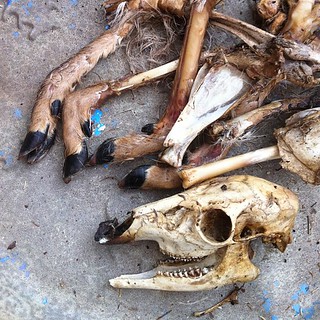
Naturally decomping deer remains, nearly ready for maceration.
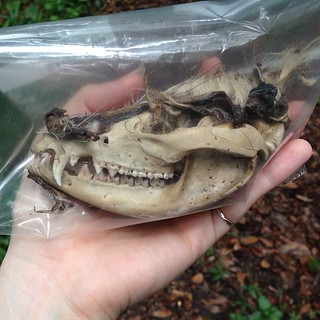
Naturally mummified opossum skull ready to macerate.

Filling up a maceration tub of deer and wild boar bones with water.

Flesh free bones after maceration.
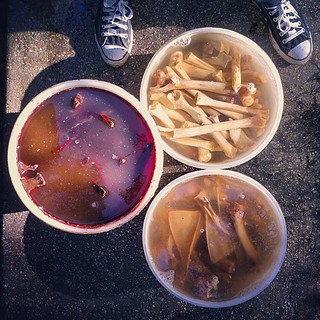
Wild boar and deer bones in different stages of maceration and degreasing.
2) Degreasing.
I honestly don't do a lot of degreasing. I've found that a lot of the oils rise to the surface during maceration. On a rare ocassion I do some extra degreasing though with a dishsoap and water soak. Or super weak ammonia and water soak. Both can take months. Also degreasing is really a personal preference of the bone collector. Some people don't care to degrease at all and some like their bones grease free.
3) Hydrogen peroxide (H2O2) bath.
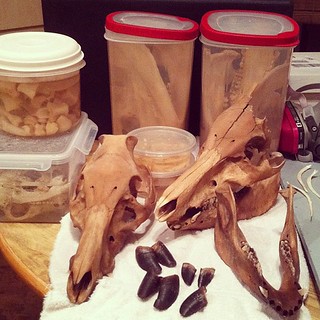
Wild boar bones and skulls in different stages of peroxide bath sanitizing and whitening.
Right now I have these skulls/bones in their final H2O2 bath. Deer skulls, goat skull & wild boar vertebrae. One deer skull is on the side to further lighten a stain. The goat skull was too big for the container so once the skull lightened it was time to do the same to the horns (minus the horn sheaths).
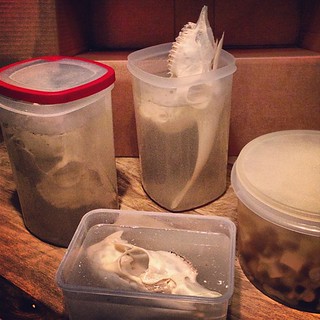
4) Drying.
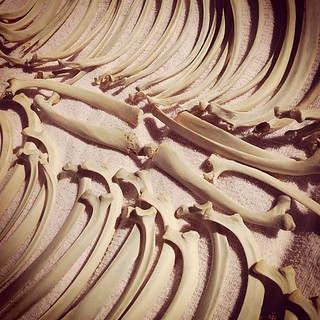
Deer and boar bones sun drying.

Finished skull example of a goat.
Want more detailed info on each step? There are extensive blog posts covering each of these steps pictured here. For more info read the rest of my related blog posts.
Maceration Info
Bad Words: BOIL & BLEACH
The Mathematics Of Maceration - A HowTo Guide For The Impatient
BONELUST BONE PROCESSING Q&A: What should the remains look like to begin maceration?
Degreasing Info
BONELUST Q&A: "How will I know if a skull needs degreasing, I'm not sure what it even looks like?"
Whitening Info
Whitening Bone Using Hydrogen Peroxide NOT Chlorine Bleach
Bad Words: BOIL & BLEACH



9 comments:
Hey Jana,
I'm mostly a skull guy... I do like the idea of masceration. I have an opossum head I'd like to clean up. Do indeed to let it decompose naturally first before the long soak? And will mace ration compromise any connective tissue in the skull leaving me with just a small pile?? Thanks for the help!!
Hi mooshi, you can likely find your answers in my previous maceration blog posts here.
The Mathematics Of Maceration - A HowTo Guide For The Impatient - http://bone-lust.blogspot.com/2012/05/mathematics-of-maceration-howto-guide.html
BONELUST BONE PROCESSING Q&A: What should the remains look like to begin maceration? - http://bone-lust.blogspot.com/2013/04/bonelust-bone-processing-q-what-should.html
Thanx for the speedy reply.... I'll read further!
Happy decomposing!!
First off, I love your blog and bone creations! I came across your IG a few months ago and have been obsessed ever since... I am new to bone collecting and have yet to start my first project. I obtained a full bird and I am not sure of the best way to let nature do its decomposing thing. I tried letting a squirrel decompose in the yard, but the carcass disappeared within a few days. I assume another creature stole it. I had read about using a "bone cage" or burying the remains, but I am very excited about this bird and don't want to make the same mistake again. do you have a tried and tested method? Would you recommend first removing some of the flesh myself? Any advice would be greatly appreciated. Thanks!
Marissa - I really hardly ever post anything anywhere in general about birds because of legal issues. Most birds you're going to come across in US/Canada are illegal to have any part of dead or alive because they are Migratory Bird Treaty Act protected species. If you were to macerate those you're likely going to end up with nothing but a stinky pile of mush. To process birds, rodents & small reptiles/amphibians you can't really macerate like larger medium sized animals. You literally have to carefully remove the feathers, skin & muscle with surgical tools, tweezers & scissors as best you can. I rarely do this myself because it is so tedious. If it is mummified it may be even harder to accomplish. Or you can soak a while in water & if you're lucky you can carefully peel away the skin from the bones & just hope that most of the muscle was already eaten away by carrion insects. I'll have to make a blog post about this sometime for sure. As well as a longer post about legal issues related to bone collecting.
Hi Jana,
I just got back from the desert and brought back a few cattle skulls with me. They look like they've been sitting out for a while, and have been picked clean, but caked with mud. I gently washed all the desert and mud out of them and left them to dry in the sun, but the Skulls appear to be weathered and splintery like barn wood. And the horns are flaking apart like old fingernail or tree bark. Are these beyond repair? Will they disintergrate? Should I remove the horn sheath and clean under? can i do anything to smooth the horn sheaths back out?
Thanks for your help!
Leighla
Hi Leighla! For bones/skulls that have been outside in the elements for a very very long time there is really not much you can do to process/preserve them. At that point it will be very brittle, light, flaky, porous, etc. There are no natural oils holding it together now. Most you can do is carefully brush it off with a toothbrush. Even washing in water could cause it to fall apart completely. If you don't mind it being shiny you could try to clear coat it with something like a spray polyurethane. But really at this point best thing to do it not to handle it much. It should not decay much anymore indoors just sitting on a shelf.
Good luck... jana
Hi
I found some vertebrae comeplately clean of flesh with a very little connective tissue in between a couple that wipped off. Should I macreate these or degrease them? Or skip to whitening? They look like the have been in the elements for a bit and are really lighthe weight for the size.
Hi Mariha Cimino… You only need to macerate if there is some flesh/tissue remaining on the bone. If they have been in the elements for a while you probably do not need to degrease. Since you have a line bit of tissue left you could macerate. Would likely remove any remaining grease as well. Then move onto peroxide whitening. Or if you went straight to the whitening step it would probably be fine as well to be honest. good luck… jana
Post a Comment